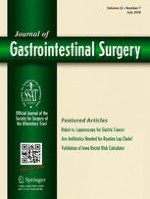Erschienen in:

07.05.2018 | Original Article
Immunohistochemical Predictors for Intestinal and Pancreatobiliary Types of Adenocarcinoma of The Ampulla of Vater
verfasst von:
João Paulo Lemos da Silveira Santos, Carla Jorge Machado, Eduardo Paulino Junior, João Bernardo Sancio Rocha Rodrigues, Paula Teixeira Vidigal, Vivian Resende
Erschienen in:
Journal of Gastrointestinal Surgery
|
Ausgabe 7/2018
Einloggen, um Zugang zu erhalten
Abstract
Objectives
To investigate immunohistochemical predictors for intestinal and pancreatobiliary types of adenocarcinoma of ampulla of Vater and identify clinicopathological characteristics associated with the histological types and patient survival.
Methods
Immunohistochemical markers included MUC1, MUC2, MUC5AC, CDX2, CK7, and CK20. The data were analyzed by univariate and multivariate methods. The two-step cluster method was used to determine the best immunohistochemical markers to discriminate the intestinal from the pancreatobiliary type.
Results
This study identified 9 (33.3%) intestinal and 21 (66.7%) pancreatobiliary tumors. CK7 and CDX2 achieved the highest value (= 1) as predictor markers, while CK20, MUC1, and MUC2 showed degrees of importance equal to 0.77, 0.71, and 0.68, respectively. MUC5AC did not reach 0.50 of importance. In the univariate analysis, lymph node involvement, staging (TNM), and angiolymphatic and perineural invasions were associated with histological types. The independent clinicopathological variable in the multivariate model to predict the histological type was angiolymphatic invasion (p = 0.005), OR = 17 (95% CI 2.33 to 123.83). The final model showed positive nodes (N1) associated with shorter survival (HR = 9.5; p = 0.006). Overall survival at 12, 36, and 60 months was 88.5, 67.0, and 47.6%, respectively.
Conclusions
CDX2 and CK7 were the immunohistochemical markers that best discriminated the intestinal from the pancreatobiliary type. Lymph node involvement had a high impact on survival and proved to be more frequent in the pancreatobiliary type.